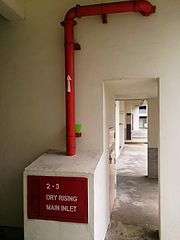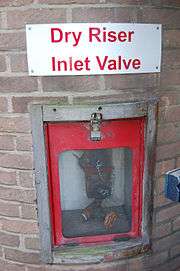Dry riser


A dry riser is a normally empty pipe that can be externally connected to a pressurized water source by firefighters. It is a vertical pipe intended to distribute water to multiple levels of a building or structure as a component of the fire suppression systems.
Most buildings have a "wet riser" or "wet standpipe" system where the pipes are kept full of water for manual or automatic fire fighting operations. Dry risers are used when the water pressure of a building wouldn't be enough for fire suppression, and in unheated buildings where the pipes could freeze. Dry risers have to allow access to a fire engine within 18 m of the dry riser inlet box. Dry risers in occupied buildings have to be within a fire-resistant shaft, usually one of a building's fire escape staircase enclosures.
Depending on regional nomenclature, the term "dry riser" may refer to a standpipe, intended to provide water to fire hose connections, or a vertical main pipe in an automatic dry pipe fire sprinkler system. A dry standpipe comprises a fire department connection, e.g. Storz, which is an external access point at ground level through which water can be pumped from the fire department's fire engine pump to firefighters' fire hose attachments on each floor, whereas a dry pipe fire sprinkler system is a network of pipes connected to fixed sprinklers inside a building, which are full of air until one of the sprinklers is triggered.The fire sprinkler is where the water comes into the building. All sprinkler systems have a check valve that keeps the sprinkler water from getting into the domestic water. The riser is also where the gauges, valves and alarm devices are located.
References
- Roger Greeno; Fred Hall (14 August 2015). Building Services Handbook. Routledge. pp. 642–. ISBN 978-1-317-61721-1.
- V. K. Jain (1 January 2007). Fire Safety In Buildings. Taylor & Francis. pp. 193–. ISBN 978-81-224-1035-8.
See also
| Wikimedia Commons has media related to Dry risers. |